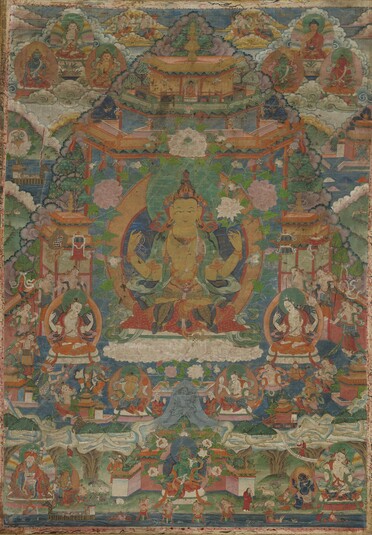
Item: Avalokiteshvara (Bodhisattva & Buddhist Deity) - Chaturbhuja (4 hands)
| Origin Location | Tibet |
|---|---|
| Date Range | 1700 - 1799 |
| Lineages | Buddhist |
| Material | Ground Mineral Pigment on Cotton |
| Collection | Private |
Alternate Names: Lokeshvara Avalokita Lokanata Lokanatha Mahakarunika
Classification: Deity
Appearance: Peaceful
Gender: Male
Avalokiteshvara, Chaturbhuja (Tibetan: chen re zi, chag shi pa. English: the All Seeing Lord with Four Hands).
The Four-armed Lokeshvara (Chaturbhuja) is the most popular and most common form of Avalokiteshvara found in art. As a sub-group amongst those there is the context of the Potalaka Pureland with Lokeshvara seated at the center in front of the celestial palace. Often, Green Tara is located below the palace in the pureland of the Rosewood Forest - special for Tara.
Potalaka is an island believed to be located somewhere in the Indian ocean off the coast of Western India. In China, Potalaka is found as Puto Island just two hours south of Shanghai. Puto Island was visited in the past by Tibetan teachers such as Karma Pakshi and Zangpo Pal as early as the Yuan period. The Potala Palace in Lhasa, Tibet, traditional home of the Dalai Lama, is named after the Potalaka pureland.
The central figure is Avalokiteshvara, with four hands. At his right is the male attendant Manidharin, white in colour, and at the left, the female, Shadakshari, white in colour. Both are similar to the Lord in colour, ornaments and appearance. Sometimes they are referred to as the son and daughter of Avalokiteshvara. The iconography for the two attendant figures is not consistent nor is it necessarily fixed in a single authoritative text. They can appear either white or yellow in colour and have either two arms or four. Often Manidharin appears with two arms and Shadakshari with four.
"As the nature of all buddhas, Avalokiteshvara, in colour like stainless conch and crystal, very resplendent, smiling, peaceful and radiant. With four hands the first are folded at the heart, the lower hold a crystal mala and jewelled lotus, two beautiful feet seated in vajra posture, adorned with many attractive silks and jewels, beautified with dark blue hair in tufts [some] loose. On the crown of the head, the wisdom of all buddhas, is the Lord, source of all refuge gathered as one, in essence the Guru in the aspect of Amitabha, in the manner of the Lord of the Family, seated happily." (Ngorchen Konchog Lhundrub 1497-1557).
At the top left are the Buddhas white Vairochana, blue Akshobhya and yellow Ratnasambhava. On the right side are Shakyamuni, green Amoghasiddhi and red Amitabha.
At the bottom center is Green Tara. On the left is Padmasambhava and at the bottom right is white Vajrasattva.
Jeff Watt 7-1998 [updated 2-2014]
Buddhist Deity: Avalokiteshvara, Chaturbhuja (Three Deity)
Buddhist Deity: Avalokiteshvara, Chaturbhuja - Four Hands - Main Page
Buddhist Deity: Avalokiteshvara (Potalaka Pureland)
